Mechanism of Acrylate Emulsion-Modified Cement-Based Materials
Abstract
:1. Introduction
2. Properties of Cement-Based Materials Modified by Acrylate Lotion
2.1. Volume Stability
2.2. Mechanical Properties
2.3. Durability
3. Mechanism of Acrylate-Lotion-Modified Cement-Based Materials
3.1. Mechanism of Acrylate-Lotion-Modified Cement-Based Materials
3.2. Physical and Chemical Mechanism of Acrylate-Lotion-Modified Cement-Based Materials
3.2.1. Physical Mechanism of Acrylate-Lotion-Modified Cement-Based Materials
3.2.2. Chemical Mechanism of Acrylate-Lotion-Modified Cement-Based Materials
3.3. Cement Hydration-Retarding Mechanism in Acrylate-Lotion-Modified Cement-Based Materials
4. Conclusions and Outlook
Funding
Conflicts of Interest
Abbreviations
| Superabsorbent polymers | SAPs |
| Styrene–butyl acrylate | SBA |
| Ethylene–vinyl acetate copolymer | EVA |
| Epoxy resin | EP |
| Styrene–butadiene rubber | SBR |
| Polyvinyl alcohol | PVA |
| Chloroprene rubber | CR |
| Styrene lotion | SA |
| Polymer-modified cement-based materials | PMCs |
| Methacrylic acid | MAA |
| Sodium styrene sulfonate | SSS |
| Methyl polyethylene glycol methacrylate | MPEGMA |
| Water-soluble monomers | WSMs |
| Carboxyl butadiene styrene latex | XSBRI |
References
- Shen, J.; Liang, J.; Lin, X.; Lin, H.; Yu, J.; Yang, Z. Recent progress in polymer-based building materials. Int. J. Polym. Sci. 2020, 2020, 8838160. [Google Scholar] [CrossRef]
- Makul, N. Advanced smart concrete-A review of current progress, benefits and challenges. J. Clean. Prod. 2020, 274, 122899. [Google Scholar] [CrossRef]
- Jiang, W.; Roy, D.M. Microstructural aspects of high-performance cement-based materials. MRS Online Proc. Libr. 1994, 370, 115–124. [Google Scholar] [CrossRef]
- Zhang, X.; Du, M.; Fang, H.; Shi, M.; Zhang, C.; Wang, F. Polymer-modified cement mortars: Their enhanced properties, applications, prospects, and challenges. Constr. Build. Mater. 2021, 299, 124290. [Google Scholar] [CrossRef]
- Yang, R. Source radon control of cement-based materials and application prospect of polymer delayed plugging strategy. J. Radioanal. Nucl. Chem. 2022, 331, 4417–4424. [Google Scholar] [CrossRef]
- Aggarwal, L.K.; Thapliyal, P.C.; Karade, S.R. Properties of polymer-modified mortars using epoxy and acrylic emulsions. Constr. Build. Mater. 2007, 21, 379–383. [Google Scholar] [CrossRef]
- Sarde, B.; Patil, Y.D. Recent research status on polymer composite used in concrete-an overview. Mater. Today Proc. 2019, 18, 3780–3790. [Google Scholar] [CrossRef]
- Shi, C.; Zou, X.; Yang, L.; Wang, P.; Niu, M. Influence of humidity on the mechanical properties of polymer-modified cement-based repair materials. Constr. Build. Mater. 2020, 261, 119928. [Google Scholar] [CrossRef]
- Cai, R.; Qi, H.; Mao, J.; Lv, J.; Jin, D. Improved crack resistance and pore structure of cement-based materials by adding EVA powder. J. Mater. Civ. Eng. 2022, 34, 04022012. [Google Scholar] [CrossRef]
- Wu, K.R.; Zhang, D.; Song, J.M. Properties of polymer-modified cement mortar using pre-enveloping method. Cem. Concr. Res. 2002, 32, 425–429. [Google Scholar] [CrossRef]
- Lin, D.; Yuan, Y.F.; Wen, Z.Y. Study on the Corrosion Resistance of Polymer-Modified Reactive Powder Concrete. Adv. Mater. Res. 2011, 250, 548–553. [Google Scholar] [CrossRef]
- Czarnecki, L. Concrete-polymer composites: Trends shaping the future. Int. J. Soc. Mater. Eng. Resour. 2007, 15, 1–5. [Google Scholar] [CrossRef]
- Thong, C.C.; Teo DC, L.; Ng, C.K. Application of polyvinyl alcohol (PVA) in cement-based composite materials: A review of its engineering properties and microstructure behavior. Constr. Build. Mater. 2016, 107, 172–180. [Google Scholar] [CrossRef]
- Pacheco-Torgal, F.; Jalali, S. Sulphuric acid resistance of plain, polymer modified, and fly ash cement concretes. Constr. Build. Mater. 2009, 23, 3485–3491. [Google Scholar] [CrossRef]
- Khayat, K.H. Viscosity-enhancing admixtures for cement-based materials—An overview. Cem. Concr. Compos. 1998, 20, 171–188. [Google Scholar] [CrossRef]
- Liu, B.; Shi, J.; Sun, M.; He, Z.; Xu, H.; Tan, J. Mechanical and permeability properties of polymer-modified concrete using hydrophobic agent. J. Build. Eng. 2020, 31, 101337. [Google Scholar] [CrossRef]
- Chandra, S.; Flodin, P. Interactions of polymers and organic admixtures on portland cement hydration. Cem. Concr. Res. 1987, 17, 875–890. [Google Scholar] [CrossRef]
- Li, Q.; Zhang, Z.; Li, Q.; Wang, K.; Jiang, D.; Hou, P.; Huang, Y.; Zhao, P. Insights on the role of particulate filler on the polymer-modified cement-based coating and its application. J. Build. Eng. 2023, 76, 107395. [Google Scholar] [CrossRef]
- Wang, R.; Zhang, L. Mechanism and durability of repair systems in polymer-modified cement mortars. Adv. Mater. Sci. Eng. 2015, 2015, 594672. [Google Scholar] [CrossRef]
- Zhang, P.; Zhang, B.; Fang, Y.; Chang, J. Study on Carbonation Resistance of Polymer-Modified Sulphoaluminate Cement-Based Materials. Materials 2022, 15, 8635. [Google Scholar] [CrossRef] [PubMed]
- Cui, Y.; Tan, Z.; An, C. Research and application of multi-functional acrylic resin grouting material. Constr. Build. Mater. 2022, 359, 129381. [Google Scholar] [CrossRef]
- Wang, R.; Wang, P.M. Application of styrene-butadiene rubber in cement-based materials. Adv. Mater. Res. 2011, 306, 588–593. [Google Scholar] [CrossRef]
- Czarnecki, L. Concrete-polymer composites C-PC–Reading with understanding. Restor. Build. Monum. 2012, 18, 135–142. [Google Scholar] [CrossRef]
- Bagheri, A.; Hashemi, S. Investigation of performance and compatibility of cement-based and polymer-modified cement-based repair concrete. In Proceedings of the Concrete Solutions: Proceedings of the Second International Conference, Saint-Malo, France, 7 June 2006; pp. 610–618. [Google Scholar]
- Eren, F.; Gödek, E.; Keskinateş, M.; Tosun-Felekoğlu, K.; Felekoğlu, B. Effects of latex modification on fresh state consistency, short term strength and long term transport properties of cement mortars. Constr. Build. Mater. 2017, 133, 226–233. [Google Scholar] [CrossRef]
- Xie, Z.; Yao, H.; Yuan, Q.; Zhong, F. The roles of water-soluble polymers in cement-based materials: A systematic review. J. Build. Eng. 2023, 73, 106811. [Google Scholar] [CrossRef]
- Chung, D.D.L. Multifunctional Cement-Based Materials; CRC Press: Boca Raton, FL, USA, 2018. [Google Scholar]
- Ohama, Y. Recent progress in concrete-polymer composites. Adv. Cem. Based Mater. 1997, 5, 31–40. [Google Scholar] [CrossRef]
- Garbev, K.; Black, L.; Beuchle, G.; Stemmermann, P. Inorganic polymers in cement based materials. Wasser-Und Geotechnol. 2002, 1, 19–30. [Google Scholar]
- Ali, D.S.H. Investigation on the Properties of Acrylic Emulsion Polymer Based Ordinary Portland Cement Concrete Reinforced with Hooked Steel Fiber. Ph.D. Thesis, Universiti Malaysia Pahang, Pekan, Malaysia, 2015. [Google Scholar]
- Guo, Z.; Ru, Y.; Song, W.; Liu, Z.; Zhang, X.; Qiao, J. Water-soluble polymers with strong photoluminescence through an eco-friendly and low-cost route. Macromol. Rapid Commun. 2017, 38, 1700099. [Google Scholar] [CrossRef]
- Khalel, H.H.Z.; Khan, M.; Starr, A. Dynamic response-based crack resistance analysis of fibre reinforced concrete specimens under different temperatures and crack depths. J. Build. Eng. 2023, 66, 105865. [Google Scholar] [CrossRef]
- Pang, X.; Sun, L.; Sun, F.; Zhang, G.; Guo, S.; Bu, Y. Cement hydration kinetics study in the temperature range from 15 C to 95 C. Cem. Concr. Res. 2021, 148, 106552. [Google Scholar] [CrossRef]
- Jansen, D.; Goetz-Neunhoeffer, F.; Lothenbach, B.; Neubauer, J. The early hydration of Ordinary Portland Cement (OPC): An approach comparing measured heat flow with calculated heat flow from QXRD. Cem. Concr. Res. 2012, 42, 134–138. [Google Scholar] [CrossRef]
- Möschner, G. A Thermodynamic Approach to Cement Hydration: The Role of Retarding Admixtures and Fe-Minerals during the Hydration of Cements. Ph.D. Thesis, ETH Zurich, Zürich, Switzerland, 2007. [Google Scholar]
- Li, S.; Mao, Z.; Deng, M. Preparation of Butyl Acrylate Copolymer Emulsion and Its Regulation Effect on Cement Hydration. Materials 2023, 16, 2887. [Google Scholar] [CrossRef]
- Esteves, L.P. Internal Curing in Cement-Based Materials. Ph.D. Thesis, Universidade de Aveiro, Aveiro, Portugal, 2009. [Google Scholar]
- Esteves, L.P.; Lukošiūtė, I.; Čėsnienė, J. Hydration of cement with superabsorbent polymers. J. Therm. Anal. Calorim. 2014, 118, 1385–1393. [Google Scholar] [CrossRef]
- Mei, J.P.; Li, H.N.; Xu, Z.D. Effect of Styrene-Acrylic Emulsion on Crack Resistance of Cement-Based Materials. In Materials Science Forum; Trans Tech Publications Ltd.: Stafa-Zurich, Switzerland, 2021; Volume 1036, pp. 288–300. [Google Scholar]
- Ercolani, G.D.; Felix, D.H.; Ortega, N.F. Crack detection in prestressed concrete structures by measuring their natural frequencies. J. Civ. Struct. Health Monit. 2018, 8, 661–671. [Google Scholar] [CrossRef]
- Thanoon, W.A.; Jaafar, M.S.; Kadir MR, A.; Noorzaei, J. Repair and structural performance of initially cracked reinforced concrete slabs. Constr. Build. Mater. 2005, 19, 595–603. [Google Scholar] [CrossRef]
- Liu, H.; Li, A.; Huang, H.; Song, X.; Wu, J.; Chen, Y.; Gao, P.; Hu, J.; Wei, J.; Yu, Q. Gradient microstructure and strain field at interfacial zone between cement-based repair and concrete substrate. Compos. Part B Eng. 2023, 260, 110775. [Google Scholar] [CrossRef]
- Mirza, J.; Mirza, M.S.; Lapointe, R. Laboratory and field performance of polymer-modified cement-based repair mortars in cold climates. Constr. Build. Mater. 2002, 16, 365–374. [Google Scholar] [CrossRef]
- Yassene, A.A.M.; Ismail, M.R.; Afify, M.S. Physicomechanical properties of irradiated SBR latex polymer-modified cement mortar composites. J. Vinyl Addit. Technol. 2020, 26, 144–154. [Google Scholar] [CrossRef]
- Qian, J.; You, C.; Wang, Q.; Wang, H.; Jia, X. A method for assessing bond performance of cement-based repair materials. Constr. Build. Mater. 2014, 68, 307–313. [Google Scholar] [CrossRef]
- Chen, B.; Qiao, G.; Hou, D.; Wang, M.; Li, Z. Cement-based material modified by in-situ polymerization: From experiments to molecular dynamics investigation. Compos. Part B Eng. 2020, 194, 108036. [Google Scholar] [CrossRef]
- Yin, B.; Qi, D.; Hua, X.; Fan, F.; Han, K.; Hou, Y.; Hou, D.; Chen, B. Mechanical properties and micro-mechanism of cement-based materials strengthened by in-situ organic-inorganic polymerization. Cem. Concr. Compos. 2023, 142, 105202. [Google Scholar] [CrossRef]
- Tian, Y.; Jin, X.; Jin, N.; Zhao, R.; Li, Z.; Ma, H. Research on the microstructure formation of polyacrylate latex modified mortars. Constr. Build. Mater. 2013, 47, 1381–1394. [Google Scholar] [CrossRef]
- Brandt, A.M. Cement-Based Composites: Materials, Mechanical Properties and Performance; CRC Press: Boca Raton, FL, USA, 2005. [Google Scholar]
- Xu, J.; Chen, X.; Yang, G.; Niu, X.; Chang, C.; Lacidogna, G. Review of research on micromechanical properties of cement-based materials based on molecular dynamics simulation. Constr. Build. Mater. 2021, 312, 125389. [Google Scholar] [CrossRef]
- Göbel, L.; Osburg, A.; Pichler, B. The mechanical performance of polymer-modified cement pastes at early ages: Ultra-short non-aging compression tests and multiscale homogenization. Constr. Build. Mater. 2018, 173, 495–507. [Google Scholar] [CrossRef]
- Yang, J.; Wang, J.; He, X.; Yu, X.; Su, Y.; Huang, J.; Oh, S. Sodium Oleate and Styrene-Acrylate Copolymer Emulsion-Modified Cement Mortar: Functional Combination of Physical Barrier and Hydrophobicity. J. Mater. Civ. Eng. 2023, 35, 04023242. [Google Scholar] [CrossRef]
- Yin, B.; Hua, X.; Qi, D.; Han, K.; Wang, P.; Hou, D.; Liu, C. Multi-scale synergistic modification and mechanical properties of cement-based composites based on in-situ polymerization. Cem. Concr. Compos. 2023, 137, 104945. [Google Scholar] [CrossRef]
- Ma, H.; Li, Z. Microstructures and mechanical properties of polymer modified mortars under distinct mechanisms. Constr. Build. Mater. 2013, 47, 579–587. [Google Scholar] [CrossRef]
- Cao, Q.Y.; Hao, T.Y.; Sun, W. Study on polymer-modified concrete for improving flexural toughness. Appl. Mech. Mater. 2013, 405, 2815–2819. [Google Scholar] [CrossRef]
- Dou, J.; Zhang, G.; Li, S.; Tian, C.; Ji, C.; Zhang, C. Properties of degraded waste pet-modified styrene-acrylic emulsions for cement materials. Adv. Civ. Eng. 2019, 2019, 4624907. [Google Scholar] [CrossRef]
- Bahranifard, Z.; Tabrizi, F.F.; Vosoughi, A.R. An investigation on the effect of styrene-butyl acrylate copolymer latex to improve the properties of polymer modified concrete. Constr. Build. Mater. 2019, 205, 175–185. [Google Scholar] [CrossRef]
- Cheng, J.; Shi, X.; Xu, L.; Zhang, P.; Zhu, Z.; Lu, S.; Yan, L. Investigation of the effects of styrene acrylate emulsion and vinyl acetate ethylene copolymer emulsion on the performance and microstructure of mortar. J. Build. Eng. 2023, 75, 106965. [Google Scholar] [CrossRef]
- Tian, Y.; Gao, P.; Wang, R.; Wang, L.; Zhong, J.; Li, J. Study on the influence of organic polymers on the physical and mechanical properties of cement-based materials. In IOP Conference Series: Earth and Environmental Science; IOP Publishing: Bristol, UK, 2020; Volume 474, p. 072028. [Google Scholar]
- Tsigarida, A.; Tsampali, E.; Konstantinidis, A.A.; Stefanidou, M. On the use of confocal microscopy for calculating the surface microroughness and the respective hydrophobic properties of marble specimens. J. Build. Eng. 2021, 33, 101876. [Google Scholar] [CrossRef]
- Zhang, X.; Li, G.; Song, Z. Influence of styrene-acrylic copolymer latex on the mechanical properties and microstructure of Portland cement/Calcium aluminate cement/Gypsum cementitious mortar. Constr. Build. Mater. 2019, 227, 116666. [Google Scholar] [CrossRef]
- Jiang, C.; Huang, S.; Gao, P.; Chen, D. Experimental study on the bond and durability properties of mortar incorporating polyacrylic ester and silica fume. Adv. Cem. Res. 2018, 30, 56–65. [Google Scholar] [CrossRef]
- Falchi, L. Study of Innovative Water Repellent Systems for the Preservation and Restoration of Artificial Stone Materials. Ph.D. Thesis, Università Ca' Foscari Venezia, Venezia, Italy, 2013. [Google Scholar]
- Jensen, O.M.; Hansen, P.F. Water-entrained cement-based materials: II. Experimental observations. Cem. Concr. Res. 2002, 32, 973–978. [Google Scholar] [CrossRef]
- Hasholt, M.T.; Jensen, O.M.; Kovler, K.; Zhutovsky, S. Can super absorent polymers mitigate autogenous shrinkage of internally cured concrete without compromising the strength? Constr. Build. Mater. 2012, 31, 226–230. [Google Scholar] [CrossRef]
- Mei, Y.-J.; Li, Z.; Wang, P.; Liang, N. Effect and Mechanism of Styrene-butadiene Rubber Latex on the Long Term Shrinking Performance of Mortar. J. Civ. Archit. Environ. Eng. 2009, 31, 142–146. [Google Scholar]
- Lewis, W.; Lewis, G. The influence of polymer latex modifiers on the properties of concrete. Composites 1990, 21, 487–494. [Google Scholar] [CrossRef]
- Su, F.; Wang, H.; Ma, X.; He, T.; Lin, Y. Review of the Influence of Acrylate Lotion on the Properties of Cement-Based Materials. Materials 2023, 16, 6597. [Google Scholar] [CrossRef]
- Assaad, J. Development and use of polymer-modified cement for adhesive and repair applications. Constr. Build. Mater. 2018, 163, 139–148. [Google Scholar] [CrossRef]
- Yuan, Q.; Xie, Z.; Yao, H.; Huang, T.; Fan, M. Hydration, mechanical properties and microstructural characteristics of cement pastes with different ionic polyacrylamides: A comparative study. J. Build. Eng. 2022, 56, 104763. [Google Scholar] [CrossRef]
- Lou, C.; Xu, J.; Wang, T.; Ren, W. Microstructure and pore structure of polymer-cement composite joint sealants. Sci. Rep. 2021, 11, 1427. [Google Scholar] [CrossRef] [PubMed]
- Bahraq, A.A.; Al-Osta, M.A.; Al-Amoudi, O.S.B.; Saleh, T.; Obot, I. Atomistic simulation of polymer-cement interactions: Progress and research challenges. Constr. Build. Mater. 2022, 327, 126881. [Google Scholar] [CrossRef]
- Hou, D.; Yu, J.; Wang, P. Molecular dynamics modeling of the structure, dynamics, energetics and mechanical properties of cement-polymer nanocomposite. Compos. Part B Eng. 2019, 162, 433–444. [Google Scholar] [CrossRef]
- Wang, M.; Wang, R.; Yao, H.; Farhan, S.; Zheng, S.; Wang, Z.; Du, C.; Jiang, H. Research on the mechanism of polymer latex modified cement. Constr. Build. Mater. 2016, 111, 710–718. [Google Scholar] [CrossRef]
- Yang, L.; Huang, Y. Microstructure and Mechanism of Polymer Cement. Integr. Ferroelectr. 2021, 215, 24–37. [Google Scholar] [CrossRef]
- Tian, Y.; Li, Z.; Ma, H.Y.; Jin, X.; Jin, N. Physical and chemical influence of polyacrylate latex on cement mortars. Adv. Mater. Res. 2011, 261, 807–811. [Google Scholar] [CrossRef]
- Peng, Y.; Zeng, Q.; Xu, S.; Zhao, G.; Wang, P.; Liu, X. BSE-IA reveals retardation mechanisms of polymer powders on cement hydration. J. Am. Ceram. Soc. 2020, 103, 3373–3389. [Google Scholar] [CrossRef]
- Zárybnická, L.; Pokorný, J.; Machotová, J.; Ševčík, R.; Šál, J.; Viani, A. Study of keto-hydrazide crosslinking effect in acrylic latex applied to Portland cements with respect to physical properties. Constr. Build. Mater. 2023, 375, 130897. [Google Scholar] [CrossRef]
- Yang, H.; Wu, L.; Liu, J.; Wang, W. The re-swelling mechanism of superabsorbent polymers (SAP) in the SAP voids of cement-based materials. Cem. Concr. Compos. 2022, 130, 104561. [Google Scholar] [CrossRef]
- Silva DA, D.; Roman, H.R.; Gleize, P.J.P. Evidences of chemical interaction between EVA and hydrating Portland cement. Cem. Concr. Res. 2002, 32, 1383–1390. [Google Scholar] [CrossRef]
- Wang, R.; Li, J.; Zhang, T.; Czarnecki, L. Chemical interaction between polymer and cement in polymer-cement concrete. Bull. Pol. Acad. Sci. Tech. Sci. 2016. [Google Scholar] [CrossRef]
- Kardon, J.B. Polymer-modified concrete. J. Mater. Civ. Eng. 1997, 9, 85–92. [Google Scholar] [CrossRef]
- Ohama, Y. Handbook of Polymer-Modified Concrete and Mortars: Properties and Process Technology; William Andrew: Norwich, NY, USA, 1995. [Google Scholar]
- Yang, Z.; Shi, X.; Creighton, A.T.; Peterson, M.M. Effect of styrene–butadiene rubber latex on the chloride permeability and microstructure of Portland cement mortar. Constr. Build. Mater. 2009, 23, 2283–2290. [Google Scholar] [CrossRef]
- Zhong, S.; Chen, Z. Properties of latex blends and its modified cement mortars. Cem. Concr. Res. 2002, 32, 1515–1524. [Google Scholar] [CrossRef]
- Guo, Y.; Ma, B.; Zhi, Z.; Tan, H.; Liu, M.; Jian, S.; Guo, Y. Effect of polyacrylic acid emulsion on fluidity of cement paste. Colloids Surf. A Physicochem. Eng. Asp. 2017, 535, 139–148. [Google Scholar] [CrossRef]
- Jenni, A.; Zurbriggen, R.; Holzer, L.; Herwegh, M. Changes in microstructures and physical properties of polymer-modified mortars during wet storage. Cem. Concr. Res. 2006, 36, 79–90. [Google Scholar] [CrossRef]
- Zhao, F.; Li, H.; Liu, S.; Chen, J. Preparation and properties of an environment friendly polymer-modified waterproof mortar. Constr. Build. Mater. 2011, 25, 2635–2638. [Google Scholar] [CrossRef]
- Konietzko, A. Polymerspezifische Auswirkungen auf das Tragverhalten modifizierter zementgebundener Betone (PCC). Ph.D. Thesis, Technische Universität Braunschweig, Braunschweig, Germany, 1988. [Google Scholar]
- Fan, L.; Xu, F.; Wang, S.; Yu, Y.; Zhang, J.; Guo, J. A review on the modification mechanism of polymer on cement-based materials. J. Mater. Res. Technol. 2023. [Google Scholar] [CrossRef]
- Afridi MU, K.; Ohama, Y.; Demura, K.; Iqbalc, M.Z. Development of polymer films by the coalescence of polymer particles in powdered and aqueous polymer-modified mortars. Cem. Concr. Res. 2003, 33, 1715–1721. [Google Scholar] [CrossRef]
- Li, B.; Tian, Y.; Zhao, R.; Duan, A.; Li, Z.; Ma, H. Microstructure and modification mechanism of polyacrylate latex modified mortars. J. ZheJiang Univ. Eng. Sci. 2014, 1, 1345–1352. [Google Scholar]
- Plank, J.; Gretz, M. Study on the interaction between anionic and cationic latex particles and Portland cement. Colloids Surf. A Physicochem. Eng. Asp. 2008, 330, 227–233. [Google Scholar] [CrossRef]
- Kong, X.; Emmerling, S.; Pakusch, J.; Rueckel, M.; Nieberle, J. Retardation effect of styrene-acrylate copolymer latexes on cement hydration. Cem. Concr. Res. 2015, 75, 23–41. [Google Scholar] [CrossRef]
- Han, D.; Chen, W.; Zhong, S. Physical retardation mechanism of latex polymer on the early hydration of cement. Adv. Cem. Res. 2018, 30, 113–122. [Google Scholar] [CrossRef]
- Mollah, M.Y.A.; Adams, W.J.; Schennach, R.; Cocke, D.L. A review of cement–superplasticizer interactions and their models. Adv. Cem. Res. 2000, 12, 153–161. [Google Scholar] [CrossRef]
- Wang, Y.; Liu, Q. Investigation on fundamental properties and chemical characterization of water-soluble epoxy resin modified cement grout. Constr. Build. Mater. 2021, 299, 123877. [Google Scholar] [CrossRef]
- Lu, Z.; Kong, X.; Zhang, C.; Xing, F.; Cai, Y.; Jiang, L.; Zhang, Y.; Dong, B. Effect of surface modification of colloidal particles in polymer latexes on cement hydration. Constr. Build. Mater. 2017, 155, 1147–1157. [Google Scholar] [CrossRef]
- Silva, D.A.; John, V.M.; Ribeiro, J.L.D.; Roman, H.R. Pore size distribution of hydrated cement pastes modified with polymers. Cem. Concr. Res. 2001, 31, 1177–1184. [Google Scholar] [CrossRef]
- Bullard, J.W.; Jennings, H.M.; Livingston, R.A.; Nonat, A.; Scherer, G.W.; Schweitzer, J.S.; Scrivener, K.L.; Thomas, J.J. Mechanisms of cement hydration. Cem. Concr. Res. 2011, 41, 1208–1223. [Google Scholar] [CrossRef]
- Dorn, T.; Blask, O.; Stephan, D. Acceleration of cement hydration–A review of the working mechanisms, effects on setting time, and compressive strength development of accelerating admixtures. Constr. Build. Mater. 2022, 323, 126554. [Google Scholar] [CrossRef]
- Su, Z.; Sujata, K.; Bijen, J.; Fraaij, A.L.A. The evolution of the microstructure in styrene acrylate polymer-modified cement pastes at the early stage of cement hydration. Adv. Cem. Based Mater. 1996, 3, 87–93. [Google Scholar] [CrossRef]
- Scrivener, K.; Ouzia, A.; Juilland, P.; Mohamed, A. Advances in understanding cement hydration mechanisms. Cem. Concr. Res. 2019, 124, 105823. [Google Scholar] [CrossRef]
- Kang, S.; Kim, J.; Moon, C.; Song, M. Early hydration-retarding mechanism of polymer-modified cement. Mater. Res. Innov. 2015, 19, S8-22–S8-26. [Google Scholar] [CrossRef]
- Nair, P.A.K.; Vasconcelos, W.L.; Paine, K.; Calabria-Holley, J. A review on applications of sol-gel science in cement. Constr. Build. Mater. 2021, 291, 123065. [Google Scholar] [CrossRef]
- Starr, J.; Soliman, E.M.; Matteo, E.N.; Dewers, T.; Stormont, J.C.; Reda Taha, M.M. Mechanical characterization of low modulus polymer-modified calcium-silicate-hydrate (C–S–H) binder. Cem. Concr. Compos. 2021, 124, 104219. [Google Scholar] [CrossRef]
- Chaudhari, O.; Biernacki, J.J.; Northrup, S. Effect of carboxylic and hydroxycarboxylic acids on cement hydration: Experimental and molecular modeling study. J. Mater. Sci. 2017, 52, 13719–13735. [Google Scholar] [CrossRef]
- Hazimmah, D.S.; Mohd, S. Mechanical characterization of acrylic—Emulsion polymer-modified concrete reinforced with steel fibre by Taguchi application. In Proceedings of the 2011 Fourth International Conference on Modeling, Simulation and Applied Optimization, Kuala Lumpur, Malaysia, 19–21 April 2011; IEEE: Piscataway, NJ, USA, 2011; pp. 1–5. [Google Scholar]
- Hazimmah, D.S.; Muthusamy, K. Characterization of steel Fiber Reinforced acrylic emulsion polymer modified concrete (SFRPMC) through X-Ray diffraction (XRD) Analysis. Appl. Mech. Mater. 2016, 833, 87–93. [Google Scholar] [CrossRef]
- Merlin, F.; Guitouni, H.; Mouhoubi, H.; Sandrine Mariot, S.; Vallée, F.; Damme, H. Adsorption and heterocoagulation of nonionic surfactants and latex particles on cement hydrates. J. Colloid Interface Sci. 2005, 281, 1–10. [Google Scholar] [CrossRef]
- Sivakumar, M.V.N. Effect of Polymer modification on mechanical and structural properties of concrete-An experimental investigation. Int. J. Civ. Struct. Eng. 2011, 1, 732. [Google Scholar]
- Lu, P.-F. Research on Toughening Effect of Epoxy Resin Emulsion and Microemulsion on Cement-based Materials. Value Eng. 2017, 36, 107–108. [Google Scholar]
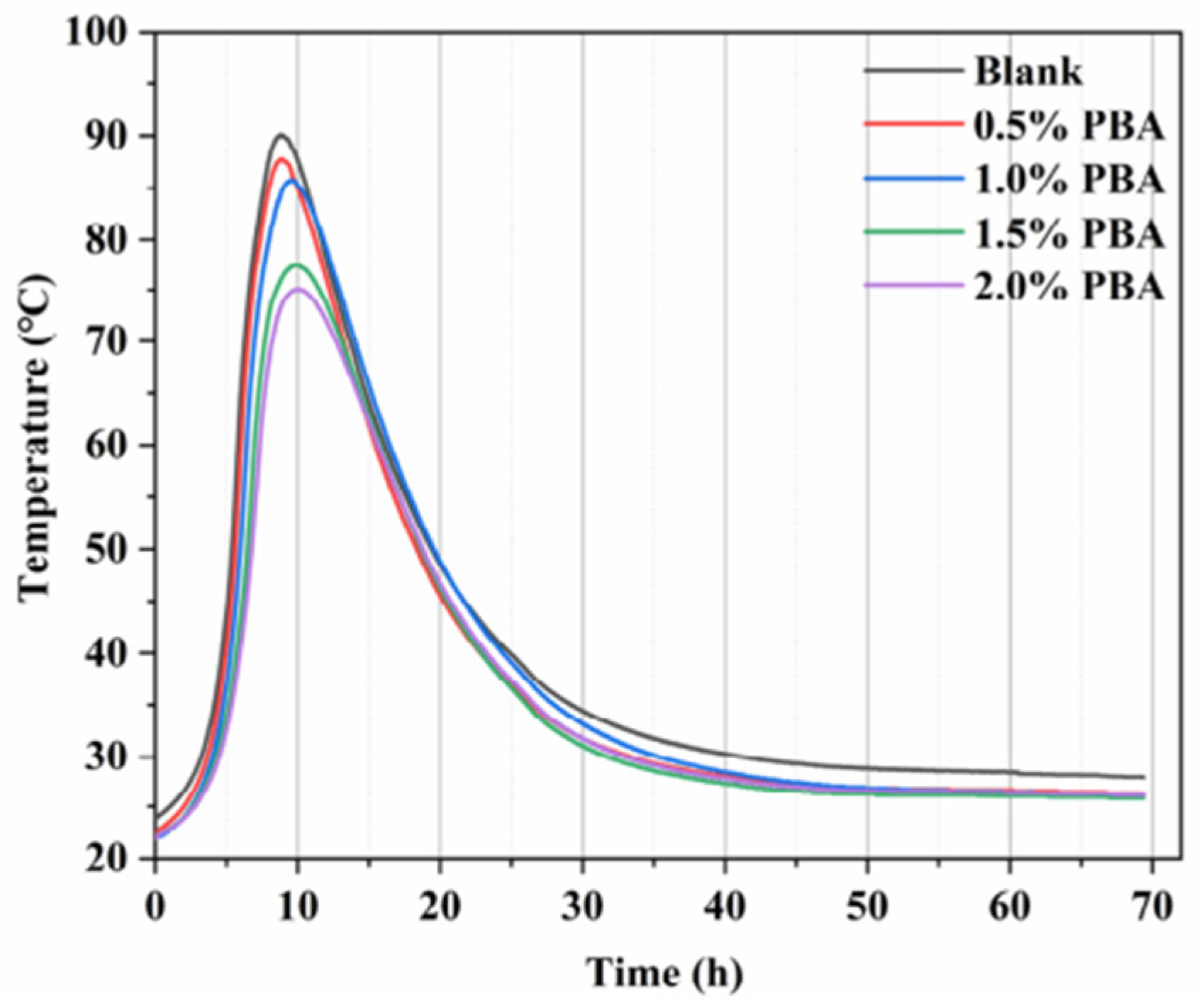
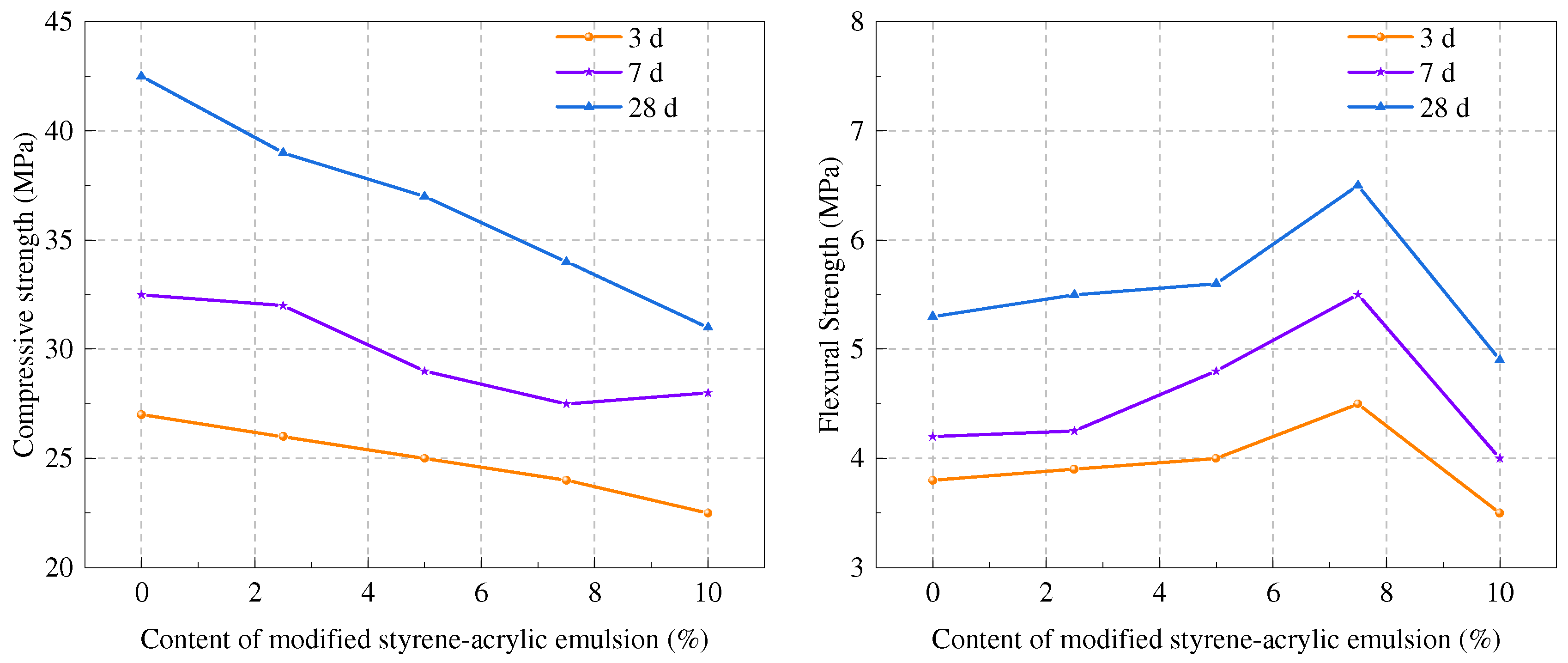





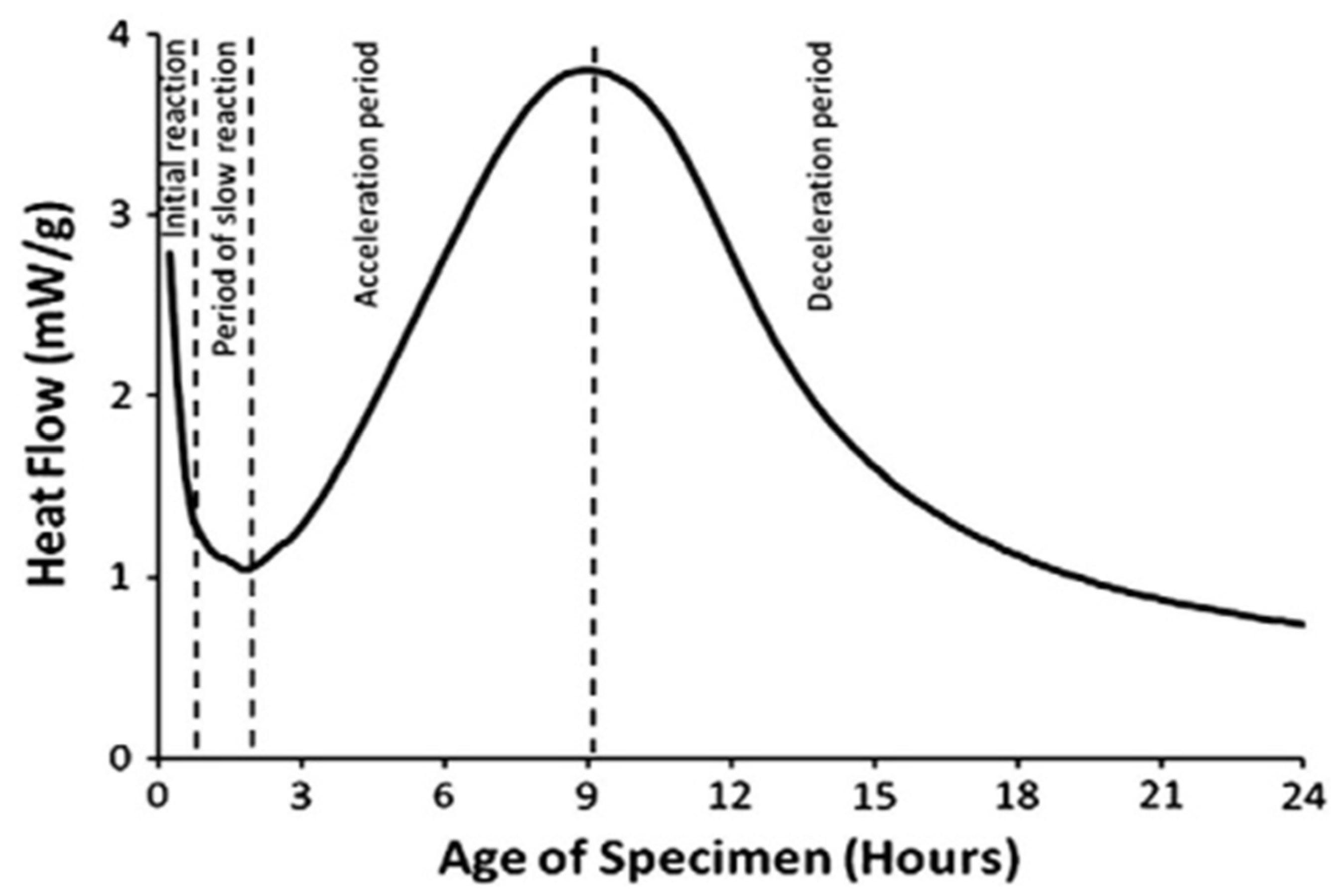
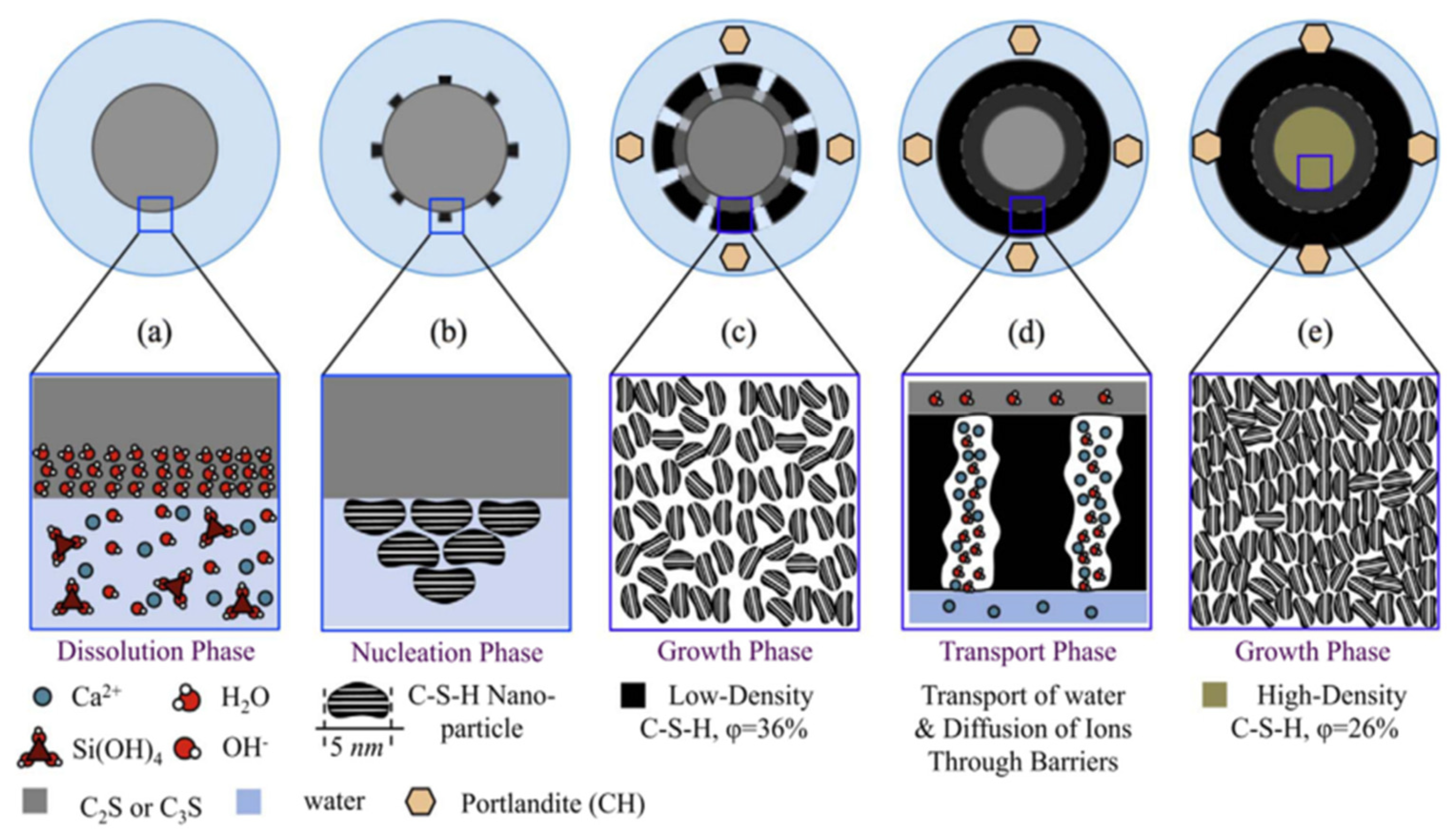
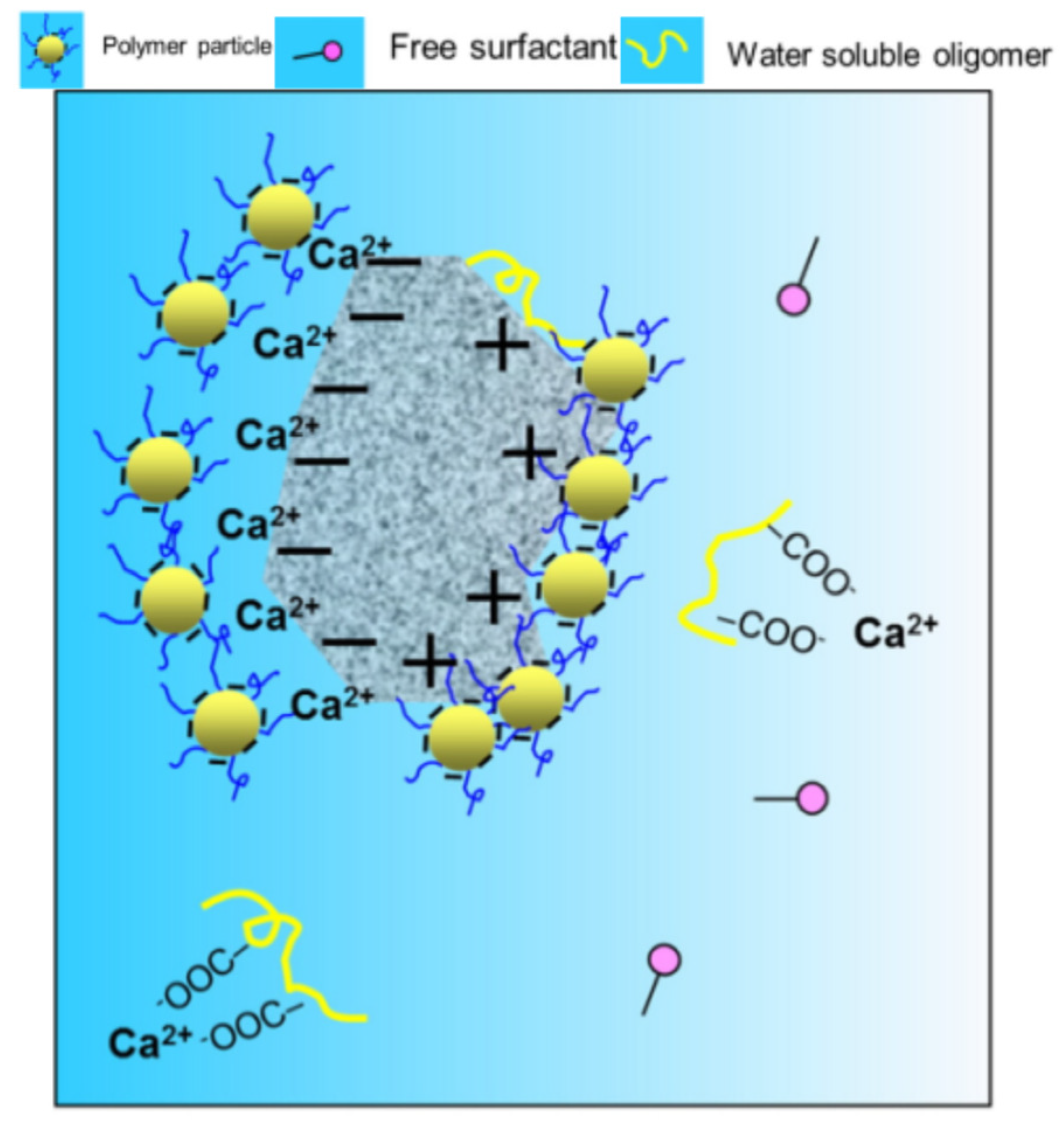
| Polymer Type | Volume Stability | Mechanical Properties |
|---|---|---|
| Superabsorbent polymers (SAPs) | SAPs can compensate for the decrease in relative humidity caused by self drying and completely eliminate self shrinkage [64] | SAPs lack a unified and reliable conclusion on the macroscopic mechanical properties of cement-based materials, and their contribution to strength ranges from 20% enhancement to 30% weakening [65] |
| Styrene–butadiene rubber (SBA) | SBA effectively improves the long-term shrinkage performance of mortar, and the larger the dosage, the smaller the long-term shrinkage deformation [66] | SBA reduces the compressive strength and elastic modulus of concrete [67] |
| Ethylene–vinyl acetate copolymer (EVA) | Mortar had no volume expansion [68] | EVA reduces the compressive strength of mortar [69] |
| Polyacrylamide [70] | Added drying shrinkage of cement samples | Anionic PAM significantly reduces the compressive strength and flexural strength of cement |
Disclaimer/Publisher’s Note: The statements, opinions and data contained in all publications are solely those of the individual author(s) and contributor(s) and not of MDPI and/or the editor(s). MDPI and/or the editor(s) disclaim responsibility for any injury to people or property resulting from any ideas, methods, instructions or products referred to in the content. |
© 2024 by the authors. Licensee MDPI, Basel, Switzerland. This article is an open access article distributed under the terms and conditions of the Creative Commons Attribution (CC BY) license (https://creativecommons.org/licenses/by/4.0/).
Share and Cite
Su, F.; He, T.; He, Z.; Yu, Q.; Wang, H. Mechanism of Acrylate Emulsion-Modified Cement-Based Materials. Molecules 2024, 29, 1260. https://doi.org/10.3390/molecules29061260
Su F, He T, He Z, Yu Q, Wang H. Mechanism of Acrylate Emulsion-Modified Cement-Based Materials. Molecules. 2024; 29(6):1260. https://doi.org/10.3390/molecules29061260
Chicago/Turabian StyleSu, Fuyun, Tingshu He, Zhongmao He, Qihao Yu, and Haiyan Wang. 2024. "Mechanism of Acrylate Emulsion-Modified Cement-Based Materials" Molecules 29, no. 6: 1260. https://doi.org/10.3390/molecules29061260





